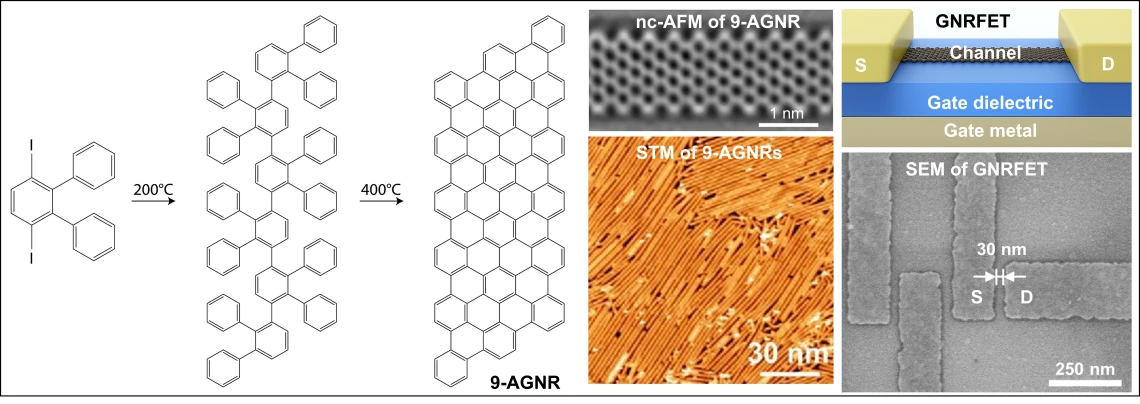ANNLab Research
Atomically Precise Graphene Nanoribbon Transistors for AI-Era Computing
As artificial intelligence (AI) workloads continue to grow exponentially, the energy and performance demands of modern computing are rapidly exceeding the limits of conventional silicon technology. With silicon scaling approaching its physical and economic boundaries, new materials and device architectures are urgently needed to achieve higher performance, lower power consumption, and enhanced functionality. Our research focuses on graphene nanoribbons (GNRs), a class of atomically precise, one-dimensional quantum materials with exceptional potential for next-generation nanoelectronic devices. Synthesized through bottom-up, on-surface chemical methods, GNRs offer tunable bandgaps, high carrier mobility, and outstanding current-carrying capacity, making them strong candidates for transistor channels tailored for advanced AI hardware. We work to bridge the gap between theoretical promise and experimental realization by advancing contact and dielectric interface engineering, bandgap and edge-state control, and device-level design to improve charge transport and carrier injection. In parallel, we are developing scalable, wafer-compatible fabrication methods to enable high-quality integration suitable for large-scale chip production. Through these efforts, our goal is to enable reliable and energy-efficient GNR-based transistor technologies that can meet the growing computational demands of the AI era. Our long-term vision is to demonstrate the first fully functional GNR microprocessor.

Topological Acoustic Wave Devices for AI-Enabled Radio-Frequency and Sensing Systems
Future radio-frequency (RF) and communication technologies, spanning 6G and beyond networks, AI-enabled edge platforms, and intelligent sensing systems, require devices that deliver high precision, low power consumption, and operational resilience. Topological acoustic (TA) wave devices offer a promising foundation for such systems by leveraging principles of topological physics to achieve robust, low-loss acoustic wave propagation, even under structural disorder or fabrication variability. Our research focuses on surface acoustic wave (SAW) architectures built on piezoelectric substrates, integrating interdigital transducers (IDTs) and engineered periodic structures to control phononic bandgaps, Bragg reflections, and acoustic dispersion with nanoscale precision. Using advanced micro- and nanofabrication methods, we develop reconfigurable, frequency-selective signal pathways tailored for intelligent RF front-end modules. These topological acoustic platforms have the potential to serve as AI-adaptive signal processors and filters, dynamically optimizing performance in response to real-time data, operating conditions, or environmental factors. By merging concepts from topological physics, acoustic engineering, and intelligent control, this work aims to establish a new class of energy-efficient, defect-tolerant RF devices that underpin the future of AI-driven communication and sensing technologies.

Semiconducting Behavior of Chalcopyrite for Sustainable Copper Mining
Chalcopyrite (CuFeS₂), the most abundant copper-bearing mineral, poses a persistent challenge in the mining industry due to its inherently low leaching efficiency. This limitation impacts both the economic viability and environmental sustainability of copper production. Recent studies suggest that the semiconducting properties of chalcopyrite play a critical role in governing its electrochemical reactivity and leaching behavior. Our research investigates the electronic transport characteristics of chalcopyrite samples sourced from various geological environments to uncover correlations between their semiconducting behavior and leaching performance. Using precise Hall effect measurements, we extract key parameters such as carrier concentration, mobility, resistivity, and conduction type under controlled temperature conditions. These measurements are complemented by microstructural and compositional analyses to link electrical performance with grain structure, morphology, and defect distribution. By combining methodologies from semiconductor physics, materials science, and mineral processing, this work aims to establish a fundamental understanding of charge transport and surface reactivity in chalcopyrite. Insights from this study will guide the design of more efficient, selective, and sustainable copper extraction processes, contributing to the development of next-generation resource recovery technologies that align with global clean-energy and circular-economy goals.

Emerging Ideas and Out-of-the-Box Science
In addition to our above flagship projects, ANNLab is pursuing several emerging research directions that extend beyond current frameworks. These studies aim to uncover new physical effects, material behaviors, and device concepts that may enable future advances in nanoelectronics and materials science. Some of these directions arise from unexpected experimental observations or cross-disciplinary connections. By maintaining flexibility in exploration and relying on careful experimentation, these early-stage ideas can evolve into well-defined research programs. The overall goal is to identify new mechanisms and design strategies that can expand the boundaries of modern electronic materials and technologies.
